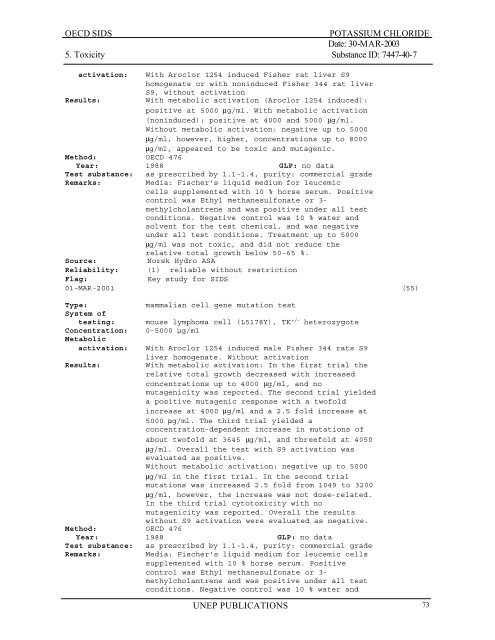POTASSIUM CHLORIDE CAS N°: 7447-40-7
POTASSIUM CHLORIDE CAS N°: 7447-40-7
POTASSIUM CHLORIDE CAS N°: 7447-40-7
Create successful ePaper yourself
Turn your PDF publications into a flip-book with our unique Google optimized e-Paper software.
OECD SIDS <strong>POTASSIUM</strong> <strong>CHLORIDE</strong><br />
Date: 30-MAR-2003<br />
5. Toxicity Substance ID: <strong>7447</strong>-<strong>40</strong>-7<br />
activation: With Aroclor 1254 induced Fisher rat liver S9<br />
homogenate or with noninduced Fisher 344 rat liver<br />
S9, without activation<br />
Results:<br />
With metabolic activation (Aroclor 1254 induced):<br />
positive at 5000 µg/ml. With metabolic activation<br />
(noninduced): positive at <strong>40</strong>00 and 5000 µg/ml.<br />
Without metabolic activation: negative up to 5000<br />
µg/ml, however, higher, concentrations up to 8000<br />
µg/ml, appeared to be toxic and mutagenic.<br />
Method: OECD 476<br />
Year: 1988 GLP: no data<br />
Test substance:<br />
Remarks:<br />
as prescribed by 1.1-1.4, purity: commercial grade<br />
Media: Fischer's liquid medium for leucemic<br />
cells supplemented with 10 % horse serum. Positive<br />
control was Ethyl methanesulfonate or 3-<br />
methylcholantrene and was positive under all test<br />
conditions. Negative control was 10 % water and<br />
solvent for the test chemical, and was negative<br />
under all test conditions. Treatment up to 5000<br />
µg/ml was not toxic, and did not reduce the<br />
relative total growth below 50-65 %.<br />
Source:<br />
Norsk Hydro ASA<br />
Reliability: (1) reliable without restriction<br />
Flag:<br />
Key study for SIDS<br />
01-MAR-2001 (55)<br />
Type:<br />
mammalian cell gene mutation test<br />
System of<br />
testing: mouse lymphoma cell (L5178Y), TK +/- heterozygote<br />
Concentration: 0-5000 µg/ml<br />
Metabolic<br />
activation: With Aroclor 1254 induced male Fisher 344 rats S9<br />
liver homogenate. Without activation<br />
Results:<br />
With metabolic activation: In the first trial the<br />
relative total growth decreased with increased<br />
concentrations up to <strong>40</strong>00 µg/ml, and no<br />
mutagenicity was reported. The second trial yielded<br />
a positive mutagenic response with a twofold<br />
increase at <strong>40</strong>00 µg/ml and a 2.5 fold increase at<br />
5000 µg/ml. The third trial yielded a<br />
concentration-dependent increase in mutations of<br />
about twofold at 3645 µg/ml, and threefold at <strong>40</strong>50<br />
µg/ml. Overall the test with S9 activation was<br />
evaluated as positive.<br />
Without metabolic activation: negative up to 5000<br />
µg/ml in the first trial. In the second trial<br />
mutations was increased 2.5 fold from 1049 to 3200<br />
µg/ml, however, the increase was not dose-related.<br />
In the third trial cytotoxicity with no<br />
mutagenicity was reported. Overall the results<br />
without S9 activation were evaluated as negative.<br />
Method: OECD 476<br />
Year: 1988 GLP: no data<br />
Test substance: as prescribed by 1.1-1.4, purity: commercial grade<br />
Remarks:<br />
Media: Fischer's liquid medium for leucemic cells<br />
supplemented with 10 % horse serum. Positive<br />
control was Ethyl methanesulfonate or 3-<br />
methylcholantrene and was positive under all test<br />
conditions. Negative control was 10 % water and<br />
UNEP PUBLICATIONS 73
















